Gorillas Experience
Gorilla Experience: The mountain gorilla (Gorilla beringei beringei) is generally one of the two subspecies of the eastern gorilla. Besides, it is listed as critically endangered by the International Union for the Conservation of Nature (IUCN).
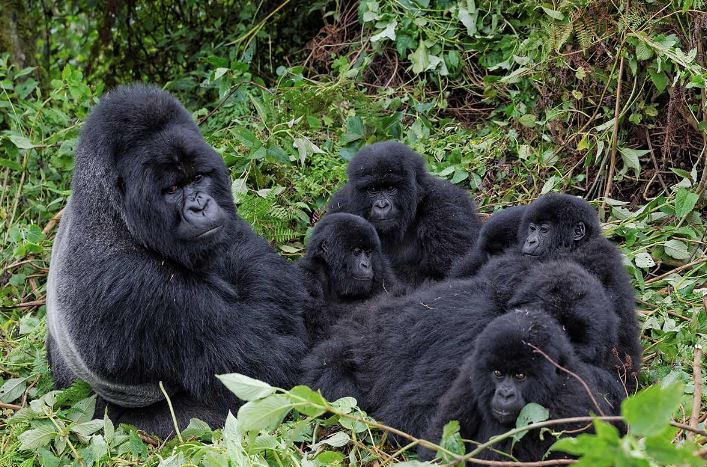
Gorilla Facts
Physical description
The fur of the gorillas is often thicker and longer than that of other gorilla species which enables them to live in colder temperatures. In addition, adult males are called silverbacks because of a saddle of gray hair which develops on their backs with age. However, the hair on their backs is shorter than on most other body parts and their arm hair long. Gorillas can be identified by nose prints unique to each individual. Males have a weight of 195 kg upright standing with a height of 150 cm and usually weigh twice as much as the females. Furthermore, adult males have more pronounced bony crests on the top and back of their skulls.

As a matter of fact, the mountain gorilla is most active between 6:00 am and 6:00 pm. Many of these hours are spent eating as large quantities of food are needed to sustain its massive bulk. It basically forages in early morning, rests during the late morning and around midday. However, in the afternoon it forages again before resting at night. More so, each gorilla builds a nest from surrounding vegetation to sleep in and constructing a new one every evening.
Only infants sleep in the same nest as their mothers. Gorillas leave their sleeping sites when the sun rises at around 6 am. Except when it is cold and overcast; then they often stay longer in their nests. Like all great apes other than humans, its arms are longer than its legs. Surprisingly, it moves by knuckle-walking, supporting its weight on the backs of its curved fingers rather than its palms.
Habitat and ecology
The mountain gorilla generally inhabits the Albertine Rift montane cloud forests and of the Virunga volcanoes. Additionally, the mountain gorilla spends most of its time in the Hagenia forests, where gallium vines are found year-round. All parts of this vine are consumed; leaves, stems, flowers as well as berries. For that reason, it travels to the bamboo forests during the few months of the year when fresh shoots are available. The mountain gorilla is primarily herbivore. Majority of its diet is composed of the leaves, shoots as well as stems. It also feeds on roots (3.3%), flowers (2.3%), and fruit (1.7%), as well as small invertebrates (0.1%). As a result, adult males can eat up to 34 kilograms of vegetation a day. On the other hand, a female can eat as much as 18 kilograms.
Behavior
The mountain gorilla is highly social and lives in relatively stable. More so, cohesive groups are held together by long-term bonds between adult males and females. The dominant silverback generally determines the movements of the group, leading it to appropriate feeding sites throughout the year. He also mediates conflicts within the group and protects it from external threats. Furthermore, when the group is attacked, the silverback will protect them even at the cost of his own life.
More silverback roles
He is also the center of attention during rest sessions. In addition. young gorillas frequently stay close to him and include him in their games. However, if a mother dies or leaves the group, the silverback is usually the one who looks after her abandoned offspring. On the other hand, when the silverback dies, the family group may be disrupted. When a new silverback joins the family group, he may kill all of the infants of the dead silverback.
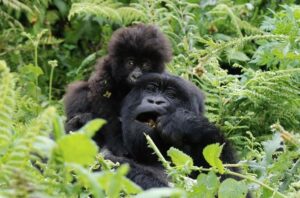 Social structure
Social structure
A typical group consists of firstly, one dominant silverback, who is the group’s undisputed leader. Secondly, another subordinate silverback (usually a younger brother, half-brother, or even an adult son of the dominant silverback). Thirdly, one or two black backs who act as sentries. Then, three to four sexually mature females who are ordinarily bonded to the dominant silverback. Lastly, from three to six juveniles and infants.
Males leave when they are about 11 years old and often the separation process is slow. However, they spend more and more time on the edge of the group until they leave altogether. Females typically emigrate when they are about 8 years old. Either transferring directly to an established group or beginning a new one with a lone male. Besides, females often transfer to a new group several times before they settle down with a certain silverback male.
Affiliation
The midday rest period is an important time for establishing and reinforcing relationships within the group. Mutual grooming also reinforces social bonds and helps keep hair free from dirt and parasites. In addition, young gorillas play often and this helps them learn how to communicate and behave within the group. Activities include; wrestling, chasing, as well as somersaults. The silverback and his females tolerate and even participate if encouraged.
Fears
For reasons unknown, mountain gorillas that have been studied appear to be naturally afraid of certain reptiles and insects. They are also afraid of water and will cross streams only if they can do so without getting wet.
Vocalization
Sounds classified as grunts and barks are heard most frequently while traveling and indicate the whereabouts of individual group members. However, they may also be used during social interactions when discipline is required. On the other hand, screams and roars are used for alarm or warning and are produced most often by silverbacks.
Aggression
Although strong and powerful, the mountain gorillas are generally gentle and very shy. Severe aggression is rare in stable groups. However, when two groups meet, the two silverbacks can sometimes engage in a fight to death.
Conservation
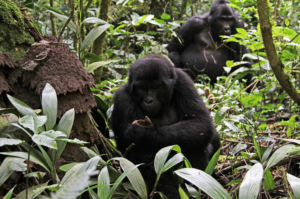
Conservation efforts have led to an increase in overall population of the mountain gorilla in the Virungas and at Bwindi. Habituated gorillas are however more closely guarded by field staff. Additionally, they receive veterinary treatment. Nonetheless, researchers recommended that some gorillas remain unhabituated as a bet-hedging strategy against the risk of human pathogens being transmitted throughout the population. Despite their recent population growth, the mountain gorilla remains threatened.
Habitat loss
This is one of the most severe threats to gorilla populations. Furthermore, the forests where mountain gorillas live are surrounded by rapidly increasing human settlement. This however leads to the reduction of the genetic diversity for each group. Through shifting (slash-and-burn) agriculture, pastoral expansion and logging, villages in forest zones cause fragmentation and degradation of habitat. The resulting deforestation confines the gorillas to isolated deserts. In addition, the impact of habitat loss extends beyond the reduction of suitable living space for gorillas.
Poaching
Mountain gorillas are not usually hunted for bush meat. But are frequently killed by traps and snares intended for other animals. They have also been killed for their heads, hands as well as feet, which are sold to collectors. Additionally, infants are sold to zoos, researchers, and people who want them as pets. The abduction of infants generally involves the loss of at least one adult. As a result, members of a group will fight to the death to protect their young
Disease
Groups subjected to regular visits from tourists and locals are at a continued risk of disease cross-transmission. Meanwhile, attempts to enforce a rule that humans and gorillas be separated by a distance of 7 metres to prevent diseases.
Gorilla Habituation
Gorilla Habituation experience was introduced by the Uganda Wildlife authority for visitors to get involved in the gorilla habituation process. More so, the adventure gives tourists more time upto 4 hours. This gives a greater chance to get to know more about the mountain gorillas. In Uganda gorilla habituation done in Bwindi Impenetrable Forest National Park and Mgahinga Forest National Park.
Groups include; Rushegura, Mubare, Bitukura, Habinyanja, Mishaya, Nkuringo, Bweza, Oruzongo, Busingye, Nshongi, Christmas, etc. However only two groups at Nkuringo and Rushaga were set aside as the gorilla families available for habituation. These include Bushaho and Bikingi Gorilla groups. Bikingi is located in the Southern sector of Bwindi National Park in Rushaga area. It is led by Bikingi silverback while Bushaho family thrives within the Nkuringo sector of Bwindi National Park.
 What is need for habituation?
What is need for habituation?
Only 4 tourists are allowed to be part of the habituation. The mountain gorilla habituation permit is sold at $1500 per person. However, it can be bought from the Uganda wildlife authority or got through a trusted tour operator. The mountain gorilla habituation permits should also be booked early enough because there are very few slots for tourists.
However, tourists going for gorilla habituation are expected to report to the national park headquarters by 7:30 am. However, the mountain gorilla habituation rules and regulations are similar to the mountain gorilla trekking rules.
Mountain Gorilla families
Uganda hosts over 17 habituated gorilla families and each gorilla family is appointed 8 gorilla permits every day for visitors. Some of the habituated gorilla families include;
Rushegura Gorilla Family
This family is located in Buhoma and has 19 members with one silverback. However, the number may change depending on members joining in and out of the group, new born arrival and death. The group separated from its former family Habinyanja 2002. In fact, it was led by Mwirimu who loved staying at a close range with his family members. But he later broke away with 7 members including 5 females, other gorillas joined him and they became 12 members. Finally, in 2010 he became stable with his family which increased to 19 members.
Meanwhile, at the age of 25 Mwirima shows his strength of ruling and even winning fights over other wild gorillas. The family used to cross to the neighboring country (Democratic Republican of Congo). However, always came back and settled in their home of Bwindi Impenetrable Forest National Park. Otherwise, this group is one of the calmest families. It is usually seen wandering around the lodge gardens or visit the souvenir shop of Gorilla Forest Camp. Surprisingly, they do not shy away from visitors, which gives them a chance to have a close look as they carry out their daily activities.
Habinyanja Gorilla Family
This habituated family is trekked in Buhoma sector. Habinyanja gorilla family derives its name from a Rukinga word “Nyanja” which means “a place with water”. However, the reason for this name is that the group was first seen near swamp ponds in the Park. Additionally, the gorilla family was habituated in 1997 and first visited by tourists in 1999.
At the time of habituation the group was led by the dominant silverback “Mugurisi” which means “Old man”. However, after passing away because of old age, the two brothers Rwansigazi and Mwirima shared power. For several years, Rwansigazi and Mwirima shared power after their father’s death. However, as time went on the two were so different and therefore the group couldn’t continue.
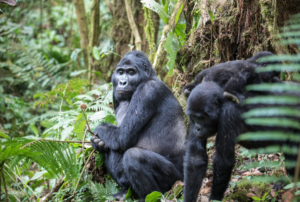
Rwansigazi was an adventurous gorilla and liked travelling. Nonetheless, Mwirima who liked his dad Mugurisi preferred to stay at a small range. In 2002 the two silverbacks decided to separate without any fights. However, those members that preferred adventure followed Rwansigazi while those who preferred a small range remained with Mwirima. The group that followed Rwansigazi maintained the name Habinyanja while those who stayed with Mwirima changed to Rushegura family.
Mubare Gorilla Family
This family is basically located in Buhoma and consists of 8 individuals including 1 silverback. The group was named after the gorgeous Mubare Hills where it was first seen. The Mubare family had 18 gorillas but because of some moving to different groups, etc this number reduced to 5 members.
In March 2012, the family was attacked by a wild gorilla group. It broke Ruhondeza’s leadership and took away some of the females. Meanwhile, old Ruhondeza took refuge in a nearby community forest. Later, continued to be monitored by researchers, until he died in his sleep on 27 June 2012. Later, Ruhondeza successor Kanyonyi managed to expand the family. It increased to eight members including a baby named Kashundwe. Gorilla trekking in this group is much adorable due to the increase in number of members. Besides, the group was filled with joy with two babies in the same year 16th October and 7th November 2019.
Bitukura Gorilla Family
This family is located in Ruhija part of Park and is the most recent habituated gorilla family. As a result, the mountain gorilla family was named after a river that bears the same name. However, habituation started in July 2007 whereby the group was opened for tourism in October 2008. It normally takes two years of habituation training but this group was ready for visitors in 15 months. The group originally consisted of 24 members but later reduced to 14 members. It is a peaceable family with four silverbacks having the second youngest silverback Ndahura as their leader. As a matter of fact, the Bitukura Gorilla Group gets along with one another.
Oruzogo Gorilla Family
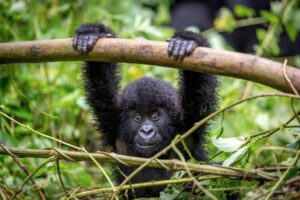
This family is found in Ruhija sector of Bwindi Impenetrable National Park and consisted of 23 members including 1 Silverback. Furthermore, the family was opened for tourism on 20th June 2011 and was led by a dominant Silverback “Tibirikwata”. In fact, this is one of the most popular families with tourists because of the playful and energetic juveniles and toddlers in the group. The family experienced a growth in number due to the births whereby this group also received more joy when a set of twins was born in March 2012.
Mishaya Gorilla Family
This family is basically located in Rushaga area in the Southwestern part of Bwindi Impenetrable Forest National Park. This family was once part of the Nshongi group but later in 2010 Silverback Mishaya decided to form its own new family. It consisted of 12 individuals with 1 silverback but figures went on changing due to births, deaths, friends etc. This Silverback was known for his aggressiveness that he fought and was seen in many battles.
Later, in 2011, Mishaya was involved in a heated fight with an unhabituated Gorilla family. This left him and a 2 year old infant with injuries all over the body. This was reported by the trackers as ‘Severely Injured.’ The injuries were eventually treated by veterinarians from the Mountain Gorilla Veterinary Project. Unfortunately, Silverback lived only 28 years and on 3rd Feb 2014 he lost his life. All of sudden, he was found dead by the Park trackers in the morning. However, he had no injuries, no history of illness and so the cause of his death was unclear.
Nshongi Gorilla Family
This group is generally located in Rushaga sector of Park and consists of 36 individuals. The word Nshongi derives from “Omushongi Gwoboki” meaning “honey” and referred to the deep color of the river. In fact, habituation begun in 2007 and it was officially launched for tourism on 26th September 2009. However, in 2010, the group split into two; the Nshongi group and newly formed family led by the Silverback Mishaya.
Nkuringo Gorilla Family
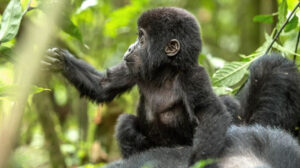
This family is found in Nkuringo sector of Park and it was opened up for tourism in 2004. Nkuringo is generally a Rukiga word meaning a “round hill”. Initially the group consisted of 17 members but went on reducing to up to 12 members. Nkuringo family was the first gorilla group to be habituated in the entire southern sector of Bwindi Impenetrable Forest National Park in 1997. Additionally, the group was led by an elder Silverback Nkuringo who died in April 2008 leaving behind two silverbacks. Safari and Rafiki and it was Safari who took over the leadership. However, this was the first gorilla family to welcome a set of twins from mother Kwitonda. They were named Katungi and Muhozi but unfortunately Katungi died at the age of 1.5 years due to illness.
Christmas Gorilla Family
This is one of the new groups located in Nkuringo sector of Park. it is led by a dominant Silverback known as Christmas who is believed to have been born on Christmas. The family consists of 9 members including 3 adult females. 3 black backs and two infants but mainly 6 members seen moving around.
Nyakagezi Gorilla Family
This is the only family inhabiting the Mgahinga National Park that protects half of the total number of Mountain Gorillas. The group consisted of 10 members with 3 silverbacks and the group was led by the Silverback Mark. However, the group liked travelling and crossing borders between Uganda, Rwanda and Democratic Republic of Congo. Later, it returned and settled at the Mgahinga National Park in 2012 with 10 members. Furthermore, news came up in 2013 when the group welcomed a new born baby increasing the number to 11 members.
Difference between Gorillas and Chimpanzees
- Male chimps are usually less than 70 kg and are around 120 cm tall. However, male gorillas weigh around 150 kg and are around 180 cm tall. As a matter of fact, females of both species weigh less than males and stand shorter.
- Gorillas have larger head crests, larger jaw muscles, larger limbs and thicker bones. Additionally, their feet and hands are less flexible. On the other hand, chimps have more slender hands and feet and their thumbs are proportionately larger.
- Chimps have proportionately larger brains and are slightly more intelligent on average.
- Gorillas have higher sexual dimorphism than chimps.
- Chimps can make simple spears, chew leaves to use as sponges, throw stones to deter baboons, use a rock and anvil to crack nuts and use a stick to fish termites. They have also been seen using sticks as weapons etc. However, gorillas have been seen using sticks to check the depth of water, make tree nests as well as fish for termites.
- Gorillas have black skin and dark brown/black hair while chimps have peach or black skin and black hair.
More differences
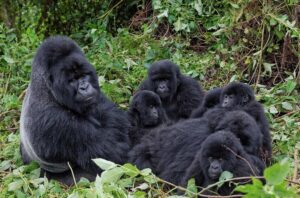
- Gorillas are mostly herbivorous but some do eat termites. They also eat fruit but in smaller quantities. Due to their larger colon and appendix, they can have a high fibre diet and they eat leaves, nettles, celery, some roots as well as stems. However, eating meat can upset their gut bacteria composition and this can cause heart diseases. Surprisingly, gorillas can spend 8 hours a day eating.
- Chimps have many males and females who have multiple breeding partners. Meanwhile, there is a strict hierarchy and chimps become higher by fighting or popularity. As a result, females leave the group to avoid inbreeding. Besides, chimps can plan and team up to remove a leader. Chimps also wage war on neighboring clans and will steal their trees, territory as well as members.
- Chimps and gorillas both live in trees but gorillas climb less due to their habitat and weight. They both nest in trees but sometimes on the ground if they are too heavy.
- As signs of aggression, chimps kick trees and scream. They show all their teeth while gorillas beat their chests and charge.
Frequently asked questions
Do you want to go for gorilla trekking but still have some questions about this great experience? Well, find most of your answers below.
What are mountain gorillas?
Gorillas are the largest living primates and they make their homes in central and east Africa. Furthermore, they function in well-developed social structure and often exhibit behavior. More so, their emotions are similar to the human experience including laughter and sadness.
How are mountain gorillas related to humans?
Gorillas generally share 98%of their DNA with humans. Furthermore, they are our closet cousins after chimpanzees and bonobos.
Where can you find mountain gorillas in Uganda and Rwanda?
In Uganda Mountain Gorillas are found in Bwindi Impenetrable National Park and Mgahinga Gorilla National Park. However, in these areas tracking takes place at 5 locations. These include; Buhoma, Ruhija, Rushaga, Nkuringo in Bwindi Impenetrable National Park and Ntebeko in Mgahinga Gorilla National Park respectively. However, the permit numbers are limited since only 8 people are allowed to visit a gorilla family per day. In Rwanda gorillas can be found in Volcanoes National Park.
What is the gestation period of Gorilla Mountains?
Females have a gestation period of 8.5 months and nurture their young for several years. Generally, females give birth to one baby every four to six years. This slow population makes it harder for gorillas to recover from any population decline.
Where do we purchase Gorilla permits in Uganda?
All gorilla permits Great Nest Image Safaris issues to clients are purchased from Uganda Wildlife Authority. Additionally, it is a Government conservation institution entrusted with managing Uganda’s national parks and game reserves.
How far can I stay from the gorillas?

Gorillas are vulnerable to transmission of diseases from humans. To this effect, tourists are expected to keep a 7 meter radius from gorillas when tracking. As a matter fact, gorillas tend to abuse this rule by coming closer to you. However, you are always encouraged to maintain this distance by staying away from the gorillas. Here, you are not allowed to touch them though it would be easy for them to come closer.
How many days should I book for my gorilla tracking tour?
You will need to set aside at least three days to see the gorillas in Uganda. Allow one day for travel, one day for the gorilla tracking and a third day for travel back. You will need to be up very early on the day of the gorilla tracking i.e 6 or 7 pm.
Where and when is it possible to track Mountain Gorillas?
Mountain gorilla tracking is generally only available in Uganda and Rwanda. Above all, gorilla trekking can be done throughout the year though best experiences happen in the dry season. In Uganda, mountain gorilla tracking is more paramount in Bwindi Forest National Park. More so, Mgahinga gorilla national park is Uganda’s second gorilla tracking destination with one gorilla family of Nyakagezi. Furthermore, Rwanda has got one mountain gorilla-tacking destination in Volcanoes national park.
How do gorillas find their food?
In areas near human communities, gorillas are attracted by crops, which they can eat. They hardly drink water directly from the source since they get the liquid from the vegetation they eat.
How does gorilla-tracking compare in Rwanda and Uganda?
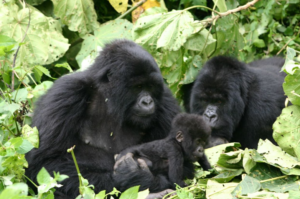
The experience of tracking mountain gorillas in Uganda and Rwanda is not so different. Most tour companies like Great Nest Image Safaris gorilla trips to have the experience of gorilla tracking in both countries. However, there are very few differences and the main one is the difference in the price of a gorilla permit. A single gorilla permit in Rwanda costs 1500USD. For Uganda, it is 700USD for foreign non residents and 250,000shs for East Africa residents.
Both countries generally have the same policies regarding trekking mountain gorillas including grouping trackers. They both allocate one hour of tracking and they both have the same rules and regulations while tracking gorillas. Another difference is in the geography of the parks whereby Bwindi in Uganda is has thick vegetation and with no clear trails. On the other hand, volcanoes national park in Rwanda is less thick and has got some clear tracking trails.
How difficult is gorilla trekking?
First of all; you must be willing to take on a hike in rough terrain and in any weather. Besides, the parks’ management also works tirelessly to help you trek the gorillas successfully regardless of all your setbacks. This is done in many ways including assigning you to park guides and rangers. This is to make it as easy as possible to track and photograph the gorillas and also ensure your security while in the wild.
How much time can I spend with the mountain gorillas?
In all gorilla destinations, tracking permits allow travelers a maximum of an hour with a habituated gorilla group. However, due to a few inconveniences your guide may allow you a few more minutes. Mountain gorillas are wild and they prefer doing their wild activities like rather than being surrounded by humans for a long time. This is why the time is restricted to one hour.
Are the mountain gorillas dangerous?
Although mountain gorillas are wild animals just like the rest in the jungle, they are not potentially dangerous. They are not aggressive or prone to be angered by tourists. However, you should not try to get in-between a mother and a baby or tease them. Secondly, don’t use a flashlight, etc as all these actions are deemed provocative to these endangered species.
Which is the best country to go gorilla trekking, Uganda or Rwanda?
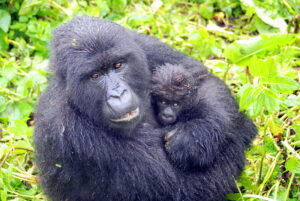
The mountain gorilla trekking in Uganda and Rwanda inhabit similar rugged terrain and have similar habits. The regulations and quality of local gorilla guides and trackers is similar in Rwanda and Uganda but there are as many factors to consider in picking your location within one of these countries. The gorilla families are not in a zoo but roaming free in a very large area of very dense forest and so many factors such as the length of your trek or how open the area you end up encountering the gorillas in, cannot be planned for. Therefore gorilla trekking in Uganda or Rwanda, all is interesting depending on your choice.
What is the trekking time?
In regards to trekking time, it starts in the early morning after a simple briefing by the park rangers/guides. Once the trekking begins, there is no specific time to spend in the jungle but vary depending on the movements of gorillas and where they slept the previous night. This means that fortunate trekkers can meet the gorillas in a short time as 30 minutes or else as late as 6 hours if not the whole day. However, whether it takes short of a long time, trekkers are 99.9% sure of meeting the gorillas.
What is included in the permit?
The permit is an inclusion of the park entrance fee, the money for the park rangers who guide during the trekking and other services in the national park except for the accommodation.
Which gorillas do you see in zoos?
All the gorillas in zoos are lowland gorillas. Most of them are actually western lowland gorillas.
How different is Gorilla trekking from Gorilla habituation?
There are so many differences between gorilla trekking and gorilla habituation. Gorilla trekking costs 700USD and you get to spend only one hour with the mountain gorillas while gorilla habituation costs 1500USD allowing you to spend four hours with the mountain gorillas. Habituation only takes places in regions that have mountain gorillas under habituation that is; in Rushaga and Nkuringo where we have Gorilla groups of Bikingi and Bushaho are under habituation.
Can I do gorilla habituation experience in any region of Bwindi?

Gorilla habituation experience is currently possible in Rushaga and Nkuringo located in Bwindi Impenetrable Forest National Park. It is thus not possible in Buhoma or Ruhija side of the forest. This is because currently, it is only in the two sectors of Rushaga and Nkuringo that we have two mountain gorilla families being habituated as compared to other regions.
When does gorilla habituation experience start?
Unlike gorilla trekking which starts at 8:30 am, mountain gorilla habituation starts at 7:30am and briefing is done much earlier.
What is included in the gorilla habituation experience permit?
This includes rangers, researchers and spending four hours with mountain gorillas under habituation. It also includes park entrance fees for Bwindi Impenetrable National Park.
How many gorilla species do we have on planet earth?
There are 4 subspecies of gorillas on our beautiful planet: the mountain gorilla, eastern lowland gorilla, western lowland gorilla, and cross river gorilla.
What is a group of gorillas called?
A group of gorillas is called a band or a troop. Up to this day, there is nowhere in the world you can see wild mountain gorillas without visiting the bands’ true natural habitat. Visit Africa and you can make your own decision on whether it’s a troop or a band.
What else can I do in Uganda besides Gorillas?
Uganda has got a lot to offer to her visitors including wonderful cultural tours, game viewing and game drives in her large wildlife parks and spectacular birding experience. When it comes to birds, Uganda may be the best safari country in Africa for a large variety of bird species and great birding safari habitats. While on your Uganda mountain gorilla safari or birding safari trip, you are likely to see many other primate species including golden monkeys and chimpanzees.
What do I need for Gorilla trekking?

We advise a pair of gloves, clothing that protects your arms and legs from thorns and nettles, long socks to enable you tack in your trousers, a hat, hiking boots, garden gloves, sun glasses, cameras and extra batteries, rain jacket, some energy giving foods and insect repellents.
Gorilla permits bookings
Great Nest Image Safaris does bookings for gorilla trekking permits, chimp permits and golden monkey permits in Uganda and Rwanda. Contact us and we will check for your permit availability and advise you accordingly. We recommend that you book your gorilla permits at least 6 months in advance to avoid disappointments.
Below are some of our short and long and long gorilla trekking safaris.
3 Days Uganda Gorilla Trekking Safari
3 Days Rwanda Gorilla Trekking Safari
4 Days Uganda Gorilla and Chimpanzee Safari
6 Days Uganda Gorilla and Wildlife Safari






